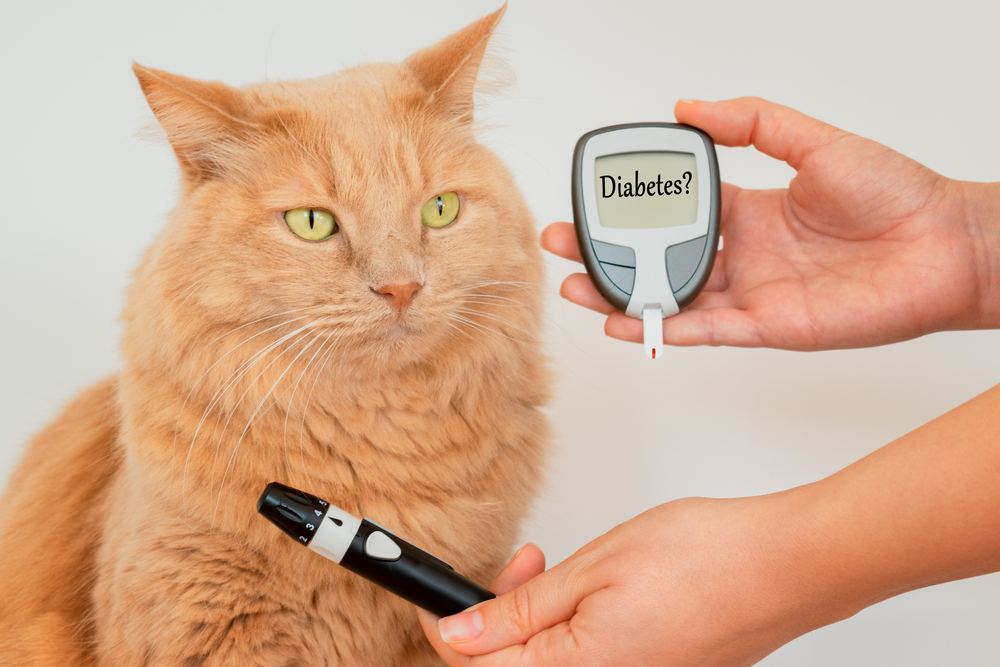Pet owners who learn that their pet is diabetic and will need lifelong care naturally feel overwhelmed—and likely intimidated—by the sudden barrage of information and instructions. Neighborhood Veterinary Centers understands your concerns and is dedicated to providing you and your newly diagnosed pet with ongoing support, guidance, and education. We want you to feel confident about your pet’s care needs and their future health.
Understand your pet’s disease
Diabetes mellitus occurs when the body cannot properly use glucose (i.e., sugar that is converted to energy). The condition is often caused by a problem in the pancreas, where insulin—the hormone that regulates blood glucose—is produced and released. Without insulin, dietary sugars in food cannot be properly transferred to the pet’s cells to be used as energy. This leads to hyperglycemia (i.e., high blood sugar) and forces the body to break down other tissues, such as fat and muscle, for usable energy.
Set diabetic pet management goals
Diabetic management involves externally supplementing the pet’s insulin with at-home glucose monitoring and daily injections. Uncontrolled diabetes can have dangerous or life-threatening consequences, including ketoacidosis, cataracts, high blood pressure, seizures, organ damage, and organ failure.
Know your veterinary team is your best resource
You will need to build a close partnership with your Neighborhood Veterinary Centers veterinarian to regulate your newly diagnosed diabetic pet. Many veterinary visits will be necessary for testing and medication adjustment. Diabetes regulation and management is patient-specific, so you should direct all questions and concerns to your pet’s veterinary team and avoid making any care changes—including diet, exercise, supplements, or medications—without approval or instruction from Neighborhood Veterinary Centers. Unauthorized changes to your pet’s routine can negatively affect your pet’s health, delay our ability to stabilize them, and worsen their clinical signs.
Learn insulin therapy for diabetic pets
If our team prescribes insulin therapy for your pet, we will coach you one-on-one and demonstrate proper insulin preparation, handling, storage, and subcutaneous (i.e., under the skin) injection techniques. Although most owners worry about giving their pet daily injections, insulin needles are small and well-tolerated by dogs and cats.
Because diabetic management is highly individual to each pet, you must follow your veterinarian’s plan to the letter, including feeding schedules and portions, insulin dosages, and glucose monitoring. Over time, your veterinarian will fine tune your pet’s regimen and you’ll develop a better understanding of your pet’s specific needs. While dogs will need lifelong insulin therapy, cats may go into remission after several months or weeks of treatment and no longer need insulin.
Closely monitor your diabetic pet
At-home monitoring is critical to diabetic management success. Your veterinarian will advise you on the most accurate monitoring method for your pet and the best frequency (i.e., once or twice daily). The simple blood-sampling glucometers currently used require only a drop of blood and are generally well-tolerated by dogs and cats, but skin-mounted sensor options are now being evaluated for pet use. Glucose can also be measured using urine testing strips, although this option is less accurate and seldom recommended. Whichever method you use, our team will help you understand and feel capable and confident about sample collection and measurement on your own.
In addition to measuring and recording your pet’s glucose levels, you will need to monitor your pet’s appetite, thirst, energy level, and urination to assess their management plan’s effectiveness. Always notify your veterinarian if you notice any change in your pet’s daily routine or behavior.
Consider therapeutic diets for diabetic pets
Therapeutic diets can improve glucose conversion and absorption and promote a more consistent blood glucose in diabetic pets. Dietary therapy is especially important for overweight or obese pets who may have some degree of insulin resistance. Therapeutic veterinary diets are generally low in carbohydrates and sodium, with high-quality protein and fiber.
Your veterinarian will make personalized food recommendations and advise you on the amount your pet needs to maintain their body condition without adding extra calories. Obesity can worsen diabetes, so we will provide weight-loss guidance for overweight pets.
Know diabetic emergency signs in pets

Diligent diabetic management and monitoring can minimize significant blood glucose highs and lows. However, owners should stay alert for signs that may indicate a glycemic crisis (e.g., hypoglycemia, hyperglycemia, diabetic ketoacidosis) and require immediate veterinary attention. Signs include:
- Weakness
- Depression
- Inappetence or increased appetite
- Increased respiratory rate
- Excessive thirst and urination
- Vomiting
- Seizures
- Muscle tremors
- Loss of coordination
- Collapse
- Unresponsiveness
Never give your pet insulin if they haven’t eaten, as this can cause hypoglycemia. If your pet demonstrates any of the above signs, test their blood glucose and contact Neighborhood Veterinary Centers for guidance. If your pet is unresponsive, excessively weak, or seizing, immediately transport them to the nearest emergency veterinary facility.
With veterinary care and ongoing management, diabetic pets can live a relatively normal existence and enjoy a great quality of life—but consistency is key. For additional information, or if you have questions about your pet’s diabetes diagnosis, contact your trusted southeast Texas neighbors at Neighborhood Veterinary Centers.






Leave A Comment